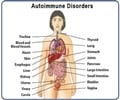A new study showed that obese patients with rheumatoid arthritis (RA) have higher DAS (disease activity) scores than non-obese patients, irrespective of their disease stage.

"Increasing levels of body fat are associated with heightened production of proinflammatory signalling proteins and raised levels of inflammatory markers. This systemic inflammation could inflate standard DAS scores and mean that obese patients receive more aggressive treatment than their non-obese counterpart," commented Dr. Christopher Sparks, Institute of Ageing and Chronic Disease, University of Liverpool, Liverpool, United Kingdom. "Not only do these results provide an explanation for the paradoxical relationship between BMI and disease outcome in RA, they clearly support the benefit to all RA patients of early and aggressive treatment."
RA is a chronic autoimmune disease that affects 0.3.0% of the general population; approximately one in 100 people worldwide. It is more prevalent among women than men, and more prevalent in developed countries.8 The symptoms of the disease, which include persistent inflammation, can lead to irreversible joint damage.
The study was presented at the European League Against Rheumatism Annual Congress (EULAR 2014). In this study, clinical data from an international RA database were used to identify an early (eRA, disease duration <12 months) and established (disease duration ≥12 months) RA cohort. Patient demographics, DAS28 and BMI were collected from the first recorded visit on the database.
The cohorts were categorised into 5 groups according to their BMI: 1) Underweight <18.5, 2) Normal 18.5-24.9, 3) Overweight 25-29.9, 4) Obese I 30-34.9 and 5) Obese II ≥35. Associations between RA disease variables and BMI category (using normal BMI as the reference group) were explored using logistic regression analysis for both the eRA and established RA cohorts, adjusting for age, gender and smoking status. Median values were used as cut offs for high DAS28 component levels.
Complete data was identified for 3,534 patients; their mean age was 54.7 (SD 14.3) and 72.5% were female. The eRA cohort was comprised 1,553 patients with <1 year of disease duration; in the established RA cohort (n=1981) the median disease duration was 7.2yrs [IQR 3.7, 13.6]. The distribution of BMI categories was similar in both the eRA and established RA cohorts (mean BMI 27.1 (SD 5.4) and 26.8 (SD 5.2) respectively).
Advertisement
Source-Eurekalert















